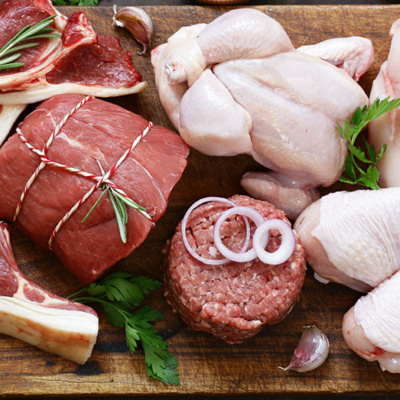top of mind news
- Industry insiders predict top tech restaurant trends of 2019
- What’s Hot in Foodservice Supply Chain 2019
- Breaking Down Minimum Wage Hikes in 2019
- With the government shut, D.C. restaurants offer deals
the farm
Poultry
 Following eight straight weeks of steady-to-lower year-over-year chicken harvests, slaughter jumped 1.5% (yoy) for the week ending December 22nd. Considerably lighter bird weights weighed on ready-to-cook production, dragging output down near 2017 levels. Heading into 2019, chicken production is forecast to expand further, but the rate of growth is expected to slow as dwindling integrator margins have left chick placement rather muted throughout the tail-end of 2018. With the government shutdown still in place, the USDA, NASS data used to calculate chick placements is unavailable, but preliminary data hints that January production may be down 3%. Wholesale chicken prices may find support amid smaller output.
Following eight straight weeks of steady-to-lower year-over-year chicken harvests, slaughter jumped 1.5% (yoy) for the week ending December 22nd. Considerably lighter bird weights weighed on ready-to-cook production, dragging output down near 2017 levels. Heading into 2019, chicken production is forecast to expand further, but the rate of growth is expected to slow as dwindling integrator margins have left chick placement rather muted throughout the tail-end of 2018. With the government shutdown still in place, the USDA, NASS data used to calculate chick placements is unavailable, but preliminary data hints that January production may be down 3%. Wholesale chicken prices may find support amid smaller output.
Beef
 Prior to the Christmas-week slowdown, beef production exceeded expectations coming in at an estimated 7.1% over the year prior; With both Christmas Eve and Christmas Day falling on weekdays this year, Christmas week beef production was light, down 12% year-over-year. December’s Cattle on Feed report confirmed expectations for smaller placements vs. 2017. With fewer cattle entering feedlots throughout the fall, expectations remain for tighter inventories of market ready cattle heading into late Q1 and extending into Q2. Beef demand was fantastic throughout 2018 and, if movement remains as brisk into 2019, risk to the wholesale beef cutouts will be to the upside this winter.
Prior to the Christmas-week slowdown, beef production exceeded expectations coming in at an estimated 7.1% over the year prior; With both Christmas Eve and Christmas Day falling on weekdays this year, Christmas week beef production was light, down 12% year-over-year. December’s Cattle on Feed report confirmed expectations for smaller placements vs. 2017. With fewer cattle entering feedlots throughout the fall, expectations remain for tighter inventories of market ready cattle heading into late Q1 and extending into Q2. Beef demand was fantastic throughout 2018 and, if movement remains as brisk into 2019, risk to the wholesale beef cutouts will be to the upside this winter.
Pork
 Pork production for the last week of 2018 fell near 10%, year-over-year, but total yearly production was up an estimated 2.6% vs. 2017. While hams and loins have certainly weighed heavy on the wholesale USDA pork cutout, spot pork belly prices caught a late-year uptrend, closing out 13% higher (yoy). The December Hogs and Pigs report confirmed expectations of expansion into 2019, with Dec 1st market hog inventories the largest on record for the month. With pork output forecast 3.1% higher in Q1 (yoy), pork prices will likely remain under pressure.
Pork production for the last week of 2018 fell near 10%, year-over-year, but total yearly production was up an estimated 2.6% vs. 2017. While hams and loins have certainly weighed heavy on the wholesale USDA pork cutout, spot pork belly prices caught a late-year uptrend, closing out 13% higher (yoy). The December Hogs and Pigs report confirmed expectations of expansion into 2019, with Dec 1st market hog inventories the largest on record for the month. With pork output forecast 3.1% higher in Q1 (yoy), pork prices will likely remain under pressure.
the sea
Seafood
 Shrimp prices remain below year ago levels. This, despite solid global demand. U.S. shrimp imports are anticipated to be strong due mostly to the inflated U.S. dollar value which should encourage supplies from abroad. That said, modest price increases for the various regional shrimp markets are projected for 2019. Snow crab prices usually soften this month and next.
Shrimp prices remain below year ago levels. This, despite solid global demand. U.S. shrimp imports are anticipated to be strong due mostly to the inflated U.S. dollar value which should encourage supplies from abroad. That said, modest price increases for the various regional shrimp markets are projected for 2019. Snow crab prices usually soften this month and next.
the garden
Produce
 The weather has been conducive for the produce crops. After experiencing upward pressure last month, the iceberg lettuce market has retreated. Since 2014, the average move for iceberg lettuce prices from mid-January through early February was down 44.3%. Fresh tomato output in Florida has been solid. Since 2014, the average move for the large mature green tomato prices over the next four weeks was down 20.1%. Avocado imports from Mexico are adequate. Hass 48 ct. avocado prices are usually choppy in January but typically decline next month.
The weather has been conducive for the produce crops. After experiencing upward pressure last month, the iceberg lettuce market has retreated. Since 2014, the average move for iceberg lettuce prices from mid-January through early February was down 44.3%. Fresh tomato output in Florida has been solid. Since 2014, the average move for the large mature green tomato prices over the next four weeks was down 20.1%. Avocado imports from Mexico are adequate. Hass 48 ct. avocado prices are usually choppy in January but typically decline next month.
the kitchen sink
Dairy
 The cheese and butter markets found modest support over the last week. According to the USDA, November milk production was up .6% year-over-year despite the milk cow herd being down .4% from 2017. The milk per cow yield was up 1% year-over-year. Dairy cows were reduced by 8k head during the month making it the smallest herd since February 2017. For the six months period ending in November, the net herd reduction was 44k head, the biggest net loss for any six-month period since November 2012. Typically cheese and butter prices increase from now through early February.
The cheese and butter markets found modest support over the last week. According to the USDA, November milk production was up .6% year-over-year despite the milk cow herd being down .4% from 2017. The milk per cow yield was up 1% year-over-year. Dairy cows were reduced by 8k head during the month making it the smallest herd since February 2017. For the six months period ending in November, the net herd reduction was 44k head, the biggest net loss for any six-month period since November 2012. Typically cheese and butter prices increase from now through early February.
Grains
 In December, nearby corn futures hit the highest level since June but have retreated in the last two weeks. Although current U.S. corn supplies are adequate, there is growing consensus that the USDA may cut their future corn production forecasts. Since 2014, nearby corn futures have averaged up 3.7% over the next six weeks.
In December, nearby corn futures hit the highest level since June but have retreated in the last two weeks. Although current U.S. corn supplies are adequate, there is growing consensus that the USDA may cut their future corn production forecasts. Since 2014, nearby corn futures have averaged up 3.7% over the next six weeks.
Oil
 In November, nearby natural gas futures hit the highest level since February 2014 but fell sharply in December. Colder temperatures have yielded to warmer weather, dampening natural gas demand. Natural gas prices can still move lower.
In November, nearby natural gas futures hit the highest level since February 2014 but fell sharply in December. Colder temperatures have yielded to warmer weather, dampening natural gas demand. Natural gas prices can still move lower.





